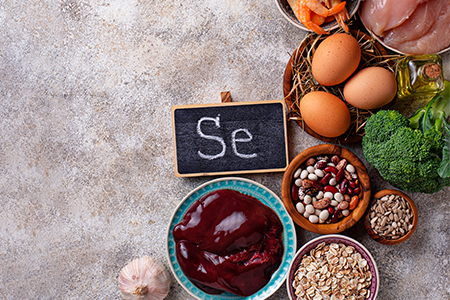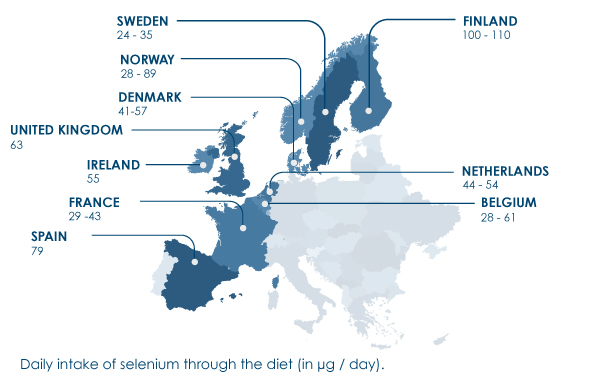Ways Pharmacy will close from Thursday, 25th December 2025 to Thursday, 1st January 2026. Operations will resume on Friday, 2nd January 2026
️️🔥LIMITED TIME SALE - UP TO 90% OFF selected items. Free Shipping for orders over £60
Bio-SelenoPrecise are small, round white tablets each containing 200 micrograms of selenium from Pharma Nord's patented, standardized selenium yeast. SelenoPrecise contains in addition to selenomethionine more than 20 other organic selenium compounds. SelenoPrecise stands out by being able to document a very high level of bio-availability and a stable quality:
Bio-SelenoPrecise contains many different selenium compounds because each type of selenium has different functions in the human body. By supplying a wide spectrum of selenium compounds it is possible to emulate the natural variety of selenium types found in selenium rich food. This, scientists believe, has the best effect on our health.
Selenium is an essential trace element that supports an array of selenoproteins and selenium-dependent enzymes that are important for human health and well-being. One of these enzymes is glutathione peroxidase (GSH-Px), which has several important functions in the body. In addition, selenium supports a normal thyroid function. The thyroid function helps the metabolism in balance. Furthermore selenium supports biological processes as:
Selenomethionine (that is embedded in different proteins instead of methionine) and selenocysteine.
We get selenomethionine from the diet exclusively because the body is unable to synthesize it. The body is, however, able to convert selenomethionine to selenocysteine, which we are also able to get from the diet in the form of se-methylselenocysteine.
In situations where we get too little dietary selenium, the body is able to use selenium that is stored in the body, simply by converting selenomethionine that is bound in different proteins.
Bio-SelenoPrecise contains both of these main selenium sources (selenomethionine and selenocysteine) plus several other selenium compounds.
In the body, selenium binds to different heavy metals and forms insoluble compounds that are eventually discharged from the body. This process consumes some of the available selenium, leaving less for other important selenium-dependent processes*. Studies show that selenium binds mercury in a 1:1 ratio.
* Schrauzer GN Selenium and selenium-antagonistic elements in nutritional cancer prevention. Crit Rev Biotechnol. 2009;29(1):10-7.
 Where do we get selenium from the diet?
Where do we get selenium from the diet?Selenium is found in such things as fish, nuts, whole-grain. People who do not consume these food items regularly may benefit from taking a selenium supplement for the sake of getting sufficient amounts of the nutrient. The recommended daily allowance (RDA) for selenium is around 50-70 μg (differs from country to country), were men generally need a little more than women.
Selenium in the agricultural soil is inorganic. Once it gets absorbed by plants (and ends up in animals) it gets converted to organic selenium. The selenium we get from our diet can be bound to amino acids such as methionine and cysteine. In contrast, selenium in supplements can either be organic or inorganic. It is known that organic selenium compounds have an easier time getting absorbed into the body and incorporated in the different selenium-dependent enzymes and selenoproteins.

In countries where the agricultural soil is rich in selenium the population has a correspondingly high selenium intake. In the United States where there is a high selenium content in the soil (especially in the northern regions), the average selenium intake is around 60-220 μg daily.
Most soils in the UK and Europe are deficient in selenium, which translates in low-selenium of farmed food and eventually, low selenium status of populations who consume local food. When the figures for Finland are not too low, it is due to the country's selenium enrichment of fertilizers.
Selenium is an element and a mineral found in the soil in varying amounts. In countries such as the United States, the agricultural land has a fairly high content of selenium, while it is relatively low in most European countries. Grain and other plants absorb selenium from the soil. Therefore, the diet's selenium content largely depends on the amount of selenium found in the agricultural land.
It is important to be aware that there are different types of selenium when selecting a selenium supplement.
In selenium supplements, inorganic selenium is often used in the form of simple selenium salts. It might be sodium selenite and sodium selenate. Selenium is usually insoluble in water, but selenium in the form of selenite and selenate is soluble in water. A little over half of these two inorganic selenium salts are absorbed into the body, selenite slightly better than selenate, however, they are also excreted quite quickly, which limits their usefulness.
Plants absorb inorganic selenium from the soil in the form of selenate. When the selenium hereafter is incorporated into the plants as selenomethionine and, to a lesser extent, selenocysteine, it becomes organic selenium. The organic selenium compound L-selenomethionine - i.e. the selenium attached to the amino acid methionine - can also be manufactured synthetically. Synthetic L-selenomethionine is widely used as organic cell supplement and is one of the most studied selenium compounds.
From animal food we primarily get selenium in the form of selenocysteine.
Selenium yeast originate from yeast cells which are grown in a selenium-containing nutrient substrate. It provides a high content of naturally occurring organic L-selenomethionine. The selenium yeast also contains methylselenocysteine as well as a variety of other organic selenium compounds that emulate the natural selenium variants found in the diet and, according to scientific studies, are important. The selenium yeast is subsequently inactivated by heat and made into a powder after which it functions as a selenium and protein rich nutrient.
There is also a difference between the quality of different yeast products. A non-standardized yeast is typically exposed to relatively large variations in the nature and amount of the various selenium compounds. This means that their absorbability can vary a lot. The yeast products that show the best properties are made as pharmaceutical grade and have a very small variation in type and amount of its various selenium compounds.